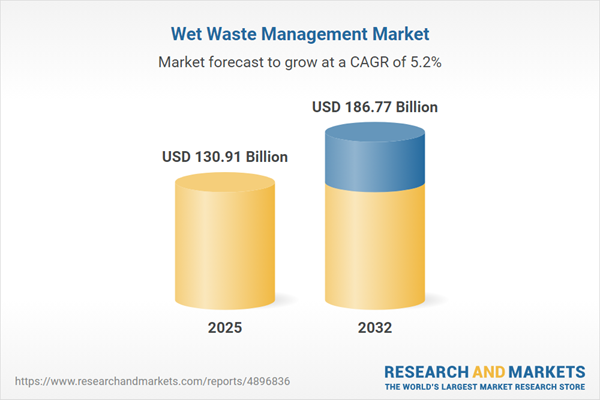Speak directly to the analyst to clarify any post sales queries you may have.
The wet waste management market is evolving rapidly as organizations and governments pursue sustainability, efficiency, and compliance within the context of rising waste volumes and stricter regulations. Senior decision-makers today demand intelligent solutions that reduce operational risk, extract additional value from organic waste streams, and future-proof waste management infrastructure.
Market Snapshot: Wet Waste Management Market Overview
According to recent analysis, the Wet Waste Management Market grew from USD 124.34 billion in 2024 to USD 130.91 billion in 2025 and is projected to advance at a CAGR of 5.21%, reaching USD 186.77 billion by 2032. Expansion is driven by global environmental imperatives, regulatory pressure, and an increased focus on resource conservation and circular economy models. The market is experiencing intensified demand for advanced sorting, treatment, and collection technologies that align with sustainability priorities while ensuring operational efficiency.
Scope & Segmentation
- Waste Types: Food Waste (Post-Consumer, Pre-Consumer), Garden Waste (Grass Clippings, Leaves), Sewage Sludge (Primary Sludge, Secondary Sludge)
- Process Technologies: Anaerobic Digestion, Composting, Vermicomposting, Thermal Processing (Gasification, Pyrolysis)
- Collection Methods: Community Drop-Off, Curbside, On-Site (In-House Collection, Third-Party Collection)
- End Users: Commercial (Food Service, Hospitality, Retail), Industrial (Chemical Manufacturing, Food Processing), Institutional, Residential
- Regions: Americas (North America: United States, Canada, Mexico; Latin America: Brazil, Argentina, Chile, Colombia, Peru), Europe, Middle East, and Africa (Europe: United Kingdom, Germany, France, Russia, Italy, Spain, Netherlands, Sweden, Poland, Switzerland; Middle East: United Arab Emirates, Saudi Arabia, Qatar, Turkey, Israel; Africa: South Africa, Nigeria, Egypt, Kenya), Asia-Pacific (China, India, Japan, Australia, South Korea, Indonesia, Thailand, Malaysia, Singapore, Taiwan)
- Leading Companies: Veolia Environnement SA, SUEZ SA, Waste Management, Inc., Republic Services, Inc., REMONDIS SE & Co. KG, Biffa plc, Clean Harbors, Inc., Covanta Holding Corporation, GFL Environmental Inc., Casella Waste Systems, Inc.
Key Takeaways for Decision-Makers
- The sector is transitioning from linear disposal models to integrated systems centered on resource recovery and environmental impact mitigation.
- Digital monitoring, automation, and advanced process controls are increasingly embedded in waste handling and treatment operations, supporting greater transparency and efficiency.
- Stakeholder collaboration, including partnerships among municipalities, private companies, and technology providers, is elevating the market's capacity for innovation and resilience.
- Regional market variation is significant, with the Americas showing strong regulatory frameworks and infrastructure, EMEA prioritizing policy harmonization, and Asia-Pacific addressing unique challenges of urbanization with scalable solutions.
- Segmentation—across waste streams, treatment technologies, and collection models—enables providers to deliver targeted service models and optimize resource allocation for diverse end users.
Assessing Tariff Impacts on Wet Waste Management Supply Chains
Recent United States tariff structures have introduced new cost dynamics, particularly affecting the procurement of specialized components for wet waste management technologies. Providers are adapting supply chain strategies, emphasizing local sourcing and materials, and accelerating proprietary technology developments to offset pricing volatility. The shift has also prompted diversified vendor relationships and enhanced risk management practices to reinforce operational stability and long-term viability.
Methodology & Data Sources
This research utilizes a comprehensive, mixed-method approach. Qualitative insights from expert interviews are integrated with primary data gathering from stakeholders and secondary reviews of policies, patents, and sustainability reports. Site visits and triangulation of findings including cross-verification among technology suppliers, operators, and end users ensure accuracy and depth. Regulatory and competitive analyses are backed by official reports and recent company disclosures.
Why This Report Matters
- Enables senior leaders to identify market drivers, risks, and emerging opportunities with clarity around regional dynamics and regulatory trends.
- Delivers actionable intelligence for optimizing investments in technologies and processes that support compliance and sustainable waste management.
- Supports precision targeting and tailored service development through detailed segmentation analysis across waste streams and user categories.
Conclusion
The wet waste management market is undergoing substantial transformation driven by technology, collaboration, and regulation. Decision-makers who embrace adaptive strategies and harness robust data will position their organizations to thrive in this sustainability-focused landscape.
Additional Product Information:
- Purchase of this report includes 1 year online access with quarterly updates.
- This report can be updated on request. Please contact our Customer Experience team using the Ask a Question widget on our website.
Table of Contents
3. Executive Summary
4. Market Overview
7. Cumulative Impact of Artificial Intelligence 2025
Companies Mentioned
The companies profiled in this Wet Waste Management market report include:- Veolia Environnement SA
- SUEZ SA
- Waste Management, Inc.
- Republic Services, Inc.
- REMONDIS SE & Co. KG
- Biffa plc
- Clean Harbors, Inc.
- Covanta Holding Corporation
- GFL Environmental Inc.
- Casella Waste Systems, Inc.
Table Information
| Report Attribute | Details |
|---|---|
| No. of Pages | 181 |
| Published | October 2025 |
| Forecast Period | 2025 - 2032 |
| Estimated Market Value ( USD | $ 130.91 Billion |
| Forecasted Market Value ( USD | $ 186.77 Billion |
| Compound Annual Growth Rate | 5.2% |
| Regions Covered | Global |
| No. of Companies Mentioned | 11 |









